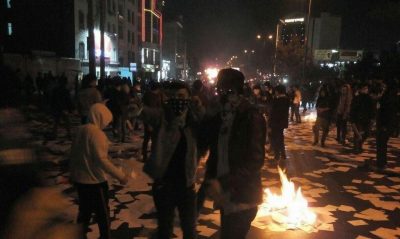Who or What Is Feeding the Unrest in Iran?

There are two general theories about the protests that are taking place in Iran. One, unfavorable to the Iranian government and establishment, is that the widespread discontent and rioting is over mismanagement of the economy that has particularly hurt poorer Iranians. The other is that we are seeing a contemporary replay of 1953 Iran and the downfall of Mohammad Mossadegh, which was orchestrated by the Central Intelligence Agency (CIA) and the British MI-6.
The Iranian public’s expectation that the nuclear deal would lead to improvements in their lives were wrecked by Donald Trump’s decertification of the agreement and expectations that the pact would be wrecked by America’s renewing sanctions on Iran later this month. All of Trump’s advisers are hostile to Iran and it has also been reported that tearing up the agreement derived from a personal pledge made by Trump to Israeli/American billionaire Sheldon Adelson, who also demanded that the US Embassy be moved to Jerusalem.
The vanishing nuclear deal and struggling economy bore fruit in the 2018 government budget that cut subsidies on food and government services while increasing fuel and commodity prices. Religious institutions controlled by the Supreme Religious Council and the business entities run by the Revolutionary Guards were reportedly spared the cuts, fueling popular anger.
If Donald Trump had really cared about the protesters or democracy, he would have said nothing about the protests. Instead, he appears intent on using the Iranian government suppression of the demonstrations to finally kill the nuclear deal by reinstating sanctions. He has tweeted five times, supporting the Iranian people who are seeking democracy but also giving the Tehran government a club to use against the demonstrators by claiming that they are tools of foreign governments, which is exactly what it is doing.
But given the history of foreign interventions in the Middle East, is the United States or Israel plausibly involved in the demonstrations? The answer to that is both yes and no. There is considerable evidence that the United States and possibly Israel, joined by Saudi Arabia, have set up several command centers in Iraq and Afghanistan to support the protests. They have been using social networking as well as radio broadcasts to encourage the people to get out and demonstrate. One such station called AmadNews, broadcasting from outside Iran, called on demonstrators to attack police stations and government buildings. It appears to be a US government front manned by Persian speaking Israelis. It’s actual ability to drive the demonstrations appears, however, to be questionable.
On the covert action front, neither the CIA or Mossad has the resources on the ground to infiltrate and direct crowds of people to act, so the Iranian government claim that there are outside agitators can largely be regarded as propaganda for its own domestic audience. The CIA’s infrastructure in Iran was devastated in the 1990s and was never effectively reconstituted. The Agency post-Director George Tenet also concentrated heavily on paramilitary activity and lost much of its ability to spot, assess, recruit, train and run agents. Developing a spy network in a country like Iran where the United States lacks any physical presence and does not even have an Embassy is a daunting task.
This is not to say that the US and Israel are not heavily focused on Iran. In a recent conference, National Security Adviser H.R. McMaster claimed, completely inaccurately, that Iran is the source of sectarian violence and supports jihadist networks “across the Arab world.” Ezra Cohen-Watnick, the National Security Council’s former senior director for intelligence had previously commented that the White House intended to use American spies to “regime change” the Iranian government.
With that objective in mind, in June new CIA Director Mike Pompeo created a special Iran combined task force under Michael D’Andrea, nicknamed the Dark Prince or Mike Ayatollah, a controversial but highly regarded Middle East specialist who is himself a convert to Islam. D’Andrea has reportedly been very active, but reconstituting a network takes time and is, of necessity, work done carefully and methodically. Pompeo, in his desire to relearn old fashioned spying and covert action, has more recently announced that the Agency will be working to recover its “viciousness,” but it is presumably not there yet.
*
Philip Giraldi, Ph.D. is Executive Director of the Council for the National Interest.
Featured image is from the author.

